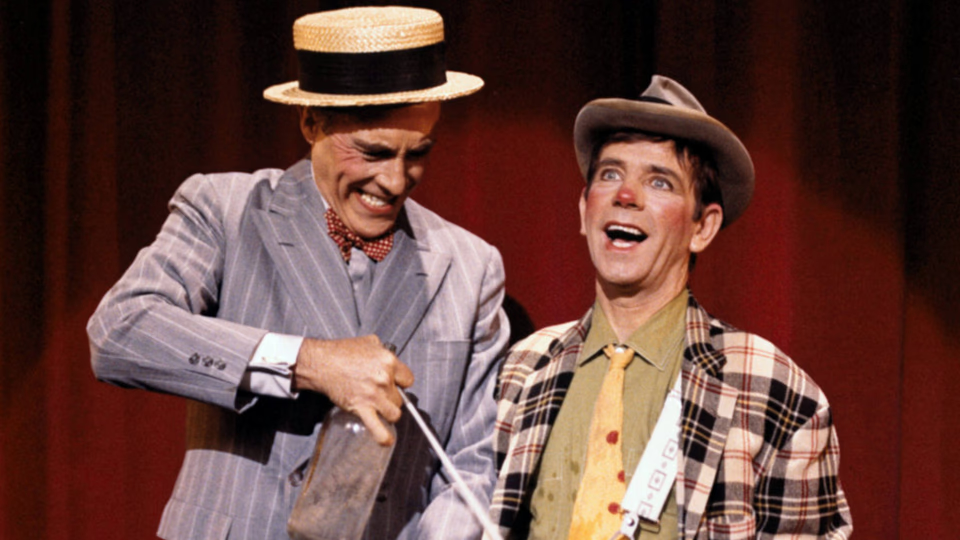The Night They Raided Minsky's

After his debut, the musical comedy Good Times starring Sonny and Cher, flopped, director William Friedkin opted for another musical comedy, this one about the waning days of burlesque. He should have known better, but given the circumstances, I understand.
Set in 1925, the film sees Britt Ekland as Rachel Schpitendavel, a young Pennsylvania Amish girl, venture into New York with dreams of becoming a dancer. She chances upon Minsky’s Burlesque theater where she meets Raymond—played by Jason Robards—the straight man in a comedy act with his clown Chick. Both men fall for her, Raymond in lust, Chick in love, causing friction in their act.
More drama comes via a nebbish vice detective who threatens to shut down the theater. Raymond hatches a plan to use Rachel to embarrass the vice detective, but Rachel and underworld boss Trim Houlihan, played by Forrest Tucker, complicate matters. Things come to a head when Rachel’s father shows up, demanding she return home, to which Rachel responds by strutting on stage and performing a striptease.
It’s all meant as a love letter to the waning days of burlesque in New York’s Lower East Side, offering both a behind-the-scenes view of the backstage drama and the audience’s view of the acts.
In his autobiography, The Friedkin Connection, Friedkin reveals how, post Good Times, he feared another flop would end his career. Thus, he passed on a lot of material. This led to concerns from his agents at William Morris. “You’re only a film director if you’re making films,” they cautioned.
Enter Bud Yorkin. Friedkin met Yorkin through Dave Wolper, a documentary producer and Friedkin’s former employer. Yorkin and Friedkin hit it off and became instant friends.
Yorkin, along with partner Norman Lear, had dominated television variety shows and sitcoms. Now they were branching into movies. They had a two-picture deal with United Artists studio head David Picker. Yorkin was going to France to direct one (Start the Revolution Without Me) and proposed Friedkin direct the other (Minsky’s) in New York.
Wrote Friedkin, “Forget for the moment that I knew nothing about burlesque in the 1920s, or how to direct a musical comedy. Forget that I had only the commercial failure of Good Times. Bud believed in me and convinced David Picker that with Norman producing, I’d bring something original and contemporary to an older subject. I was offered $100,000, which was huge.”
His “something original and contemporary” translated into a documentary-style approach—realistic lighting, candid audience reaction shots, and natural performances. They lend ample verisimilitude but betrays the acts’ illusions. Being so close to the performers, we see the rote memorization behind the feigned inspiration. The tired eyes and worn bodies beneath the makeup and costumes. Burlesque never looked so unappealing.
Though his approach doesn’t work, I understand Friedkin’s rationale. He’s compensating for a script that trades on a non-existent nostalgia, assuming the viewer’s familiarity and love for burlesque. Take the burlesque scenes out, and you’re left with four underwritten characters with suspect motivations and no clear protagonist.
The casting doesn’t help and proved the first red flag. Friedkin and Lear’s first choice for Raymond was Tony Curtis. He agreed but asked for rewrites to beef up the material. “You gotta tell Norman to put some meat on the bones,” Curtis said.
After the rewrites and three weeks before Lear and Friedkin were to leave for New York to prep the film, Curtis dropped out. They turned to Alan Alda, who agreed but couldn’t escape a Broadway commitment. Thus, the part went to Robards.
Though Robards’ resemblance to Humphrey Bogart helps, he and Ekland have no chemistry. In one scene, they stare into each other’s eyes in a costume shop, while Chick haggles over the price of a prop snake. The scene conveys no sense of mutual attraction. She falls for him because the script says she must, and when Robards reconsiders using her we’re supposed to root for him. Never mind said change only happens after he sleeps with her and betrays Chick, his friend and partner.
Ekland’s character proves no more endearing. One could spin her bouncing from Raymond to Trim as a story of female empowerment, but Ekland’s naïve performance robs her character of any calculated agency. The uneven tone leaves us wondering if we’re meant to cheer or pity her.
With such a shaky foundation, it’s unsurprising Friedkin floundered. “There were many problems with it, but the biggest was my own ineptitude,” he wrote. “I had researched the period but I didn’t know how to convey the right tone. I was in over my head.”
After filming wrapped, Friedkin, eager to wash his hands of the affair, turned in his rough cut and left for London to start production on
Indeed, Ferro’s magic trick-like device of morphing seeming archival footage to color current footage lends an immediate sense of authenticity and authority. Unlike Friedkin’s documentary style, this device enhances, rather than detracts from the proceedings.
Still, while the film proves difficult to recommend, it marks a step up from Good Times. Most should still avoid it, but film students and serious Friedkin fans should find value. As an honest failure and semi-aborted project, it still feels like a Friedkin film—just not a good one.